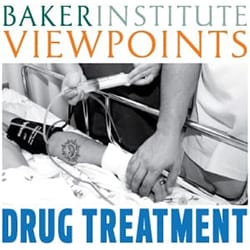Drug policy has experienced an interesting shift recently. Along with legalization of medical and recreational marijuana, many states are also reducing penalties for nonviolent drug offenses and placing greater focus on treatment for drug users. The emphasis on treatment and rehabilitation for drug users is the result of many factors, including recognition that the drug war has not reduced drug use, a desire to reduce the prison population and save money, and a surge in the rate of overdoses from opioid and heroin use. What remains to be seen is whether the current popularity of drug treatment will become a more permanent feature of drug policy. In this Baker Institute Viewpoints series, which runs through Friday, five experts on drug policy examine the question, “Is the current emphasis on treatment in drug policy a short-term trend or is it here to stay?” The second commentary follows. Yesterday’s entry covered the stigma surrounding substance use.
Lately, the drug policy landscape has been awash with calls for decriminalization (mostly for marijuana) and expanded drug rehabilitation. The treatment conversation has grown louder as increases in prescription opioid and heroin overuse and overdose deaths have made national headlines. The Centers for Disease Control and Prevention found that from 2010 to 2012 the heroin overdose rate doubled in 28 states. Less publicized was the finding that prescription opioids accounted for twice as many overdose deaths as heroin during that time. From 2004 to 2011, emergency room visits involving misuse or overuse of prescription opioids rose 183 percent. In 2014, 42 states said prescription drug overuse was the most important or a very important substance use concern.
The concurrent increases in overdoses via prescription opioids and heroin are not a coincidence. Both are largely the result of the increasing prevalence of and overexposure to prescription painkillers and an increase in heroin supply. In the early 2000s the federal government began cracking down on the over-prescription of painkillers; this drove up the street price of these meds, leading some drug users to turn to heroin as a cheaper alternative for a similar high. While most prescription drug users do not go on to use heroin, three out of four heroin users report having overused prescription drugs prior to taking up heroin. This was a consequence predicted by some drug experts in the federal government, though only in the last few years have federal authorities more vocally supported greater access to drugs such as naloxone, which helps reverse overdoses, and methadone, which helps with heroin withdrawal.
Some states have responded to the uptick in opioid and heroin use by finding new ways to punish suppliers. Louisiana recently passed a new law that doubles the mandatory minimum sentence for anyone convicted of selling heroin to 10 years. In the Northeast, law enforcement in Pennsylvania, New York, New Jersey and Massachusetts have formed a task force to fight the heroin distribution chains that span state borders. Crackdowns on drug trafficking generally do not reduce the availability of drugs. When they do successfully target a particular drug, users simply turn to other substances, evident in the current prescription opioid/heroin conundrum. In the drug market, as in any other market, if a demand exists, someone will supply it.
Many states recognize this and are paying greater attention to drug treatment. Some are adopting a dual enforcement/treatment approach, as in New Jersey, which along with its involvement in the Northeast task force is looking to expand funding for drug treatment and education, and Massachusetts, which has increased access to drug treatment and expanded distribution of naloxone. Several states have created or expanded efforts to educate the public about prescription drug and heroin dependence and to provide treatment services. Nineteen states have taken action to reduce the stigma attached to opioid-use disorders, and as of 2014 at least 21 states have made efforts to make naloxone more accessible in the community. For its part, Congress is considering the U.S. Comprehensive Addiction and Recovery Act of 2014, introduced in the Senate in September, which could provide state and local governments with up to $80 million to spend on drug prevention, treatment and recovery programs.
While drug treatment has always been one tenet of state and federal drug policy, current attitudes toward substance use suggest a departure from the zero tolerance approach that was the dominant drug policy stance in the 1980s and the decades that followed. While governments are a long way from abandoning law enforcement strategies, treatment is now playing a greater role in drug policy. Why? Surely some of the treatment focus comes from the recognition that old drug war policies have failed at everything but gobbling up government resources. In light of recent budget crises, states are eager to save money, and reforming drug laws as a means to reduce incarceration rates is becoming an increasingly popular way to cut costs. Recent studies showing that treatment is cost effective and can reduce recidivism rates make the case for pursuing expanded rehabilitation options over greater law enforcement spending.
Fiscal motivations are one part of the story. But changing characteristics of the drug user population also likely play a role. Historically, race and class have been deeply ingrained features of drug policy. Racial animosity toward Chinese immigrants in the 1870s drove criminalization of opium smoking, the preferred method of opium use among the Chinese. Other methods of opium use, popular among white women, remained legal. In the 1950s, concern over the increase in heroin use among black men, a trend that was real but also exaggerated by the media, led to particularly punitive legislation directed toward this drug, such as one provision in the 1956 Narcotics Control Act authorizing the death penalty for selling heroin to a minor. In the highly symbolic rhetoric of the 1980s drug war, politicians and the media portrayed the crack epidemic as a plague of the urban ghetto that threatened to ravage the suburbs.
Today, typical opioid users are no longer “bums under bridges.” The modern opioid epidemic is whiter, more female and more rural than previous epidemics. Between 1993 and 2009, the rate of white prescription overdose patients increased 7.5 times, compared to 3.3 times for blacks and 3.2 times for Hispanics. The rate of heroin overdose hospital admissions for blacks and Hispanics actually declined between 1995 and 2005, while the rate of heroin overdose admissions for whites increased. By 2008, whites were hospitalized for heroin overdose at a higher rate than blacks, for the first time since 1993.
Women now account for a greater portion of overdose deaths than in the past. Between 1999 and 2010, prescription opioid overdose deaths rose 400 percent for women, compared to 265 percent for men. Rural America is also increasingly affected: Between 1999 and 2004, prescription opioid overdose deaths increased 371 percent, compared to 52 percent in large urban counties. Instead of the typically marginalized “junkie” user, opioid and heroin use disorders today are affecting white people, particularly women — a group that society is hesitant to lock up so easily.
Perceptions of drug users are also changing. While a majority of Americans still view drug use as a major problem, two-thirds agree that the government should focus more on providing treatment. Media coverage of prescription drug overuse has exposed the public to a new form of substance use disorder, one that may hit closer to home than past stories of drug addicts. Millions of Americans have or know someone who has taken prescription painkillers. This makes addiction to these drugs a more relatable experience and thus one that is perceived as more deserving of treatment than punishment. The recent overdose death of actor Philip Seymour Hoffman and the outpour of public grief and the calls for addiction treatment that followed are indications of this trend.
While it may seem as if we are undergoing a profound shift in approaches to drug use, this is not necessarily the case. Treatment has always been a part of drug policy, with periodic shifts in emphasis between law enforcement and rehabilitation. That a primary driving force behind drug policy reform is fiscal may result in a “leaner and meaner” criminal justice system, one that reduces jail sentences for drug law violations, but spends too little on treatment and relies too much on fines to punish drug users suffering from addiction — a punishment that will invariably fall harder on poor and minority populations.
I don’t mean to sound pessimistic. Some recent developments do suggest that this time is different, especially with respect to marijuana. But to the extent that drug addiction remains stigmatized, the possibility of a shift back toward greater punishment exists. It is therefore critical to have an honest discussion about drug addiction that frames it as a disease requiring treatment rather than a crime requiring punishment. If the conversation changes, there is hope that a movement toward more sensible drug policy will continue.
 Katharine A. Neill, Ph.D., is the Alfred C. Glassell III Postdoctoral Fellow in Drug Policy at the Baker Institute. Her current research focuses on state sentencing policies for drug offenders and the legalization of medical and recreational marijuana. Neill’s other research interests include criminal justice policy, the private prison industry and the use of public-private partnerships to deliver public services.
Katharine A. Neill, Ph.D., is the Alfred C. Glassell III Postdoctoral Fellow in Drug Policy at the Baker Institute. Her current research focuses on state sentencing policies for drug offenders and the legalization of medical and recreational marijuana. Neill’s other research interests include criminal justice policy, the private prison industry and the use of public-private partnerships to deliver public services.
